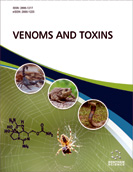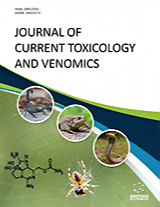Abstract
Venoms from the deadliest animals, including spiders, scorpians, bees, and centipedes, are composed of a complex mixture of various peptides developed to catch prey and defend other animals. Venoms are composed of several bioactive molecules such as proteins and peptides that modify physiological conditions in other organisms. These bioactive peptides penetrate tissues and blood vessels to encounter numerous receptors and modulate ion channel their activities. Venoms are used to treat various medical issues, including cardiovascular diseases. Venom peptides regulate several ion channel behaviors, such as voltage-gated sodium (Nav), calcium (Cav) and potassium (Kv) channels, and are set as a therapeutic approach. In this perspective, we emphasize the effect of isolated lethal venomous peptides on cardiac ionic channels and their mechanisms of action for the cure. We also summarize the highlights and molecular details of their toxin-receptor interactions and prospects to develop peptide therapeutics for respective cardiac electrophysiological diseases.
Keywords: Venoms, peptides, cardiac diseases, ion channels, currents, voltage gated channels.
Graphical Abstract
[http://dx.doi.org/10.1002/pmic.201900324] [PMID: 32820606]
[http://dx.doi.org/10.1038/nrd1197] [PMID: 14526382]
[http://dx.doi.org/10.1074/mcp.RA117.000431]
[http://dx.doi.org/10.3390/toxins12040230]
[http://dx.doi.org/10.1517/14712598.2011.621940] [PMID: 21939428]
[http://dx.doi.org/10.1091/mbc.8.11.2101] [PMID: 9362055]
[http://dx.doi.org/10.1074/jbc.R109.076596]
[http://dx.doi.org/10.1016/j.toxicon.2013.04.008] [PMID: 23624383]
[http://dx.doi.org/10.1152/physrev.00020.2003] [PMID: 14715910]
[http://dx.doi.org/10.1248/bpb.31.1279] [PMID: 18520069]
[http://dx.doi.org/10.1161/ATVBAHA.119.312004] [PMID: 31017824]
[http://dx.doi.org/10.1146/annurev.bi.64.070195.002425] [PMID: 7574491]
[http://dx.doi.org/10.1007/s00424-017-2079-7] [PMID: 29127493]
[http://dx.doi.org/10.1074/jbc.M102548200] [PMID: 11369778]
[http://dx.doi.org/10.1001/jamacardio.2018.0385] [PMID: 29641820]
[http://dx.doi.org/10.3389/fevo.2019.00218]
[PMID: 12974396]
[http://dx.doi.org/10.1021/acs.jcim.7b00395]
[http://dx.doi.org/10.1016/j.bcp.2020.114105] [PMID: 32579959]
[http://dx.doi.org/10.1007/s00246-012-0303-y] [PMID: 22460359]
[http://dx.doi.org/10.1177/1535370218777972] [PMID: 29806494]
[http://dx.doi.org/10.1016/j.toxicon.2005.06.002] [PMID: 16051296]
[http://dx.doi.org/10.1021/acschemneuro.7b00406]
[http://dx.doi.org/10.1113/JP274693] [PMID: 28621020]
[http://dx.doi.org/10.1016/j.neuropharm.2018.02.016] [PMID: 29474819]
[http://dx.doi.org/10.1016/j.toxicon.2006.09.014] [PMID: 17087985]
[http://dx.doi.org/10.1021/bi026546a]
[http://dx.doi.org/10.1038/s41467-020-20078-3] [PMID: 33397917]
[http://dx.doi.org/10.1152/advan.00114.2018] [PMID: 30694709]
[http://dx.doi.org/10.1089/zeb.2010.0653]
[http://dx.doi.org/10.1016/S0005-2736(02)00576-X]
[http://dx.doi.org/10.1038/nature00978] [PMID: 12214225]
[http://dx.doi.org/10.1007/s00018-015-1948-5] [PMID: 26070303]
[http://dx.doi.org/10.1016/j.cardiores.2003.12.026] [PMID: 15023549]
[http://dx.doi.org/10.1152/physrev.00022.2013]
[http://dx.doi.org/10.1016/j.toxicon.2012.04.337] [PMID: 22543187]
[http://dx.doi.org/10.1016/j.bpj.2020.11.1610]
[http://dx.doi.org/10.1152/physrev.00036.2011]
[http://dx.doi.org/10.1016/j.toxicon.2006.09.025] [PMID: 17097705]
[http://dx.doi.org/10.1007/s00424-003-1125-9] [PMID: 12905030]
[http://dx.doi.org/10.1093/oxfordjournals.bmb.a070715] [PMID: 5812102]
[http://dx.doi.org/10.1085/jgp.200308812] [PMID: 12771193]
[http://dx.doi.org/10.1016/j.toxicon.2020.11.008] [PMID: 33212100]
[http://dx.doi.org/10.1124/jpet.105.085928] [PMID: 15947038]
[http://dx.doi.org/10.2170/jjphysiol.47.11] [PMID: 9159640]
[http://dx.doi.org/10.1038/s41598-020-66673-8] [PMID: 32555258]
[http://dx.doi.org/10.1073/pnas.1300684110]
[http://dx.doi.org/10.1021/pr300881d]
[http://dx.doi.org/10.1073/pnas.1714760115]
[http://dx.doi.org/10.1016/j.str.2018.10.022] [PMID: 30554841]
[http://dx.doi.org/10.1002/psc.2588] [PMID: 24464516]
[http://dx.doi.org/10.1101/cshperspect.a003947] [PMID: 21746798]
[http://dx.doi.org/10.1529/biophysj.106.099028] [PMID: 17351009]
[http://dx.doi.org/10.2174/1570159X11311060005] [PMID: 24396337]
[http://dx.doi.org/10.1007/BF00374372] [PMID: 8584405]
[http://dx.doi.org/10.1007/s13273-020-00109-2]
[http://dx.doi.org/10.1097/j.pain.0000000000002041] [PMID: 32826759]
[http://dx.doi.org/10.1124/pr.57.4.5] [PMID: 16382099]
[http://dx.doi.org/10.1016/j.toxicon.2013.07.012] [PMID: 23891887]
[http://dx.doi.org/10.1016/S0028-3908(99)00267-1] [PMID: 10884557]
[http://dx.doi.org/10.1016/S0006-3495(01)75681-0] [PMID: 11423396]
[http://dx.doi.org/10.1016/S0041-0101(00)00150-1] [PMID: 11024489]
[http://dx.doi.org/10.1016/j.bbrc.2007.02.168]
[http://dx.doi.org/10.1016/j.toxicon.2013.10.029] [PMID: 24211312]
[http://dx.doi.org/10.1016/j.bcp.2020.114107] [PMID: 32579958]
[http://dx.doi.org/10.1016/j.neuropharm.2017.07.011] [PMID: 28716449]
[http://dx.doi.org/10.1021/pr060368g]
[http://dx.doi.org/10.1085/jgp.115.5.583] [PMID: 10779316]
[http://dx.doi.org/10.1046/j.1365-2141.2002.03878.x] [PMID: 12406072]
[http://dx.doi.org/10.1038/35051165] [PMID: 11343101]
[http://dx.doi.org/10.1038/nn0901-902] [PMID: 11528421]
[http://dx.doi.org/10.1074/jbc.M305410200]
[http://dx.doi.org/10.1074/jbc.272.11.7173]
 3
3




